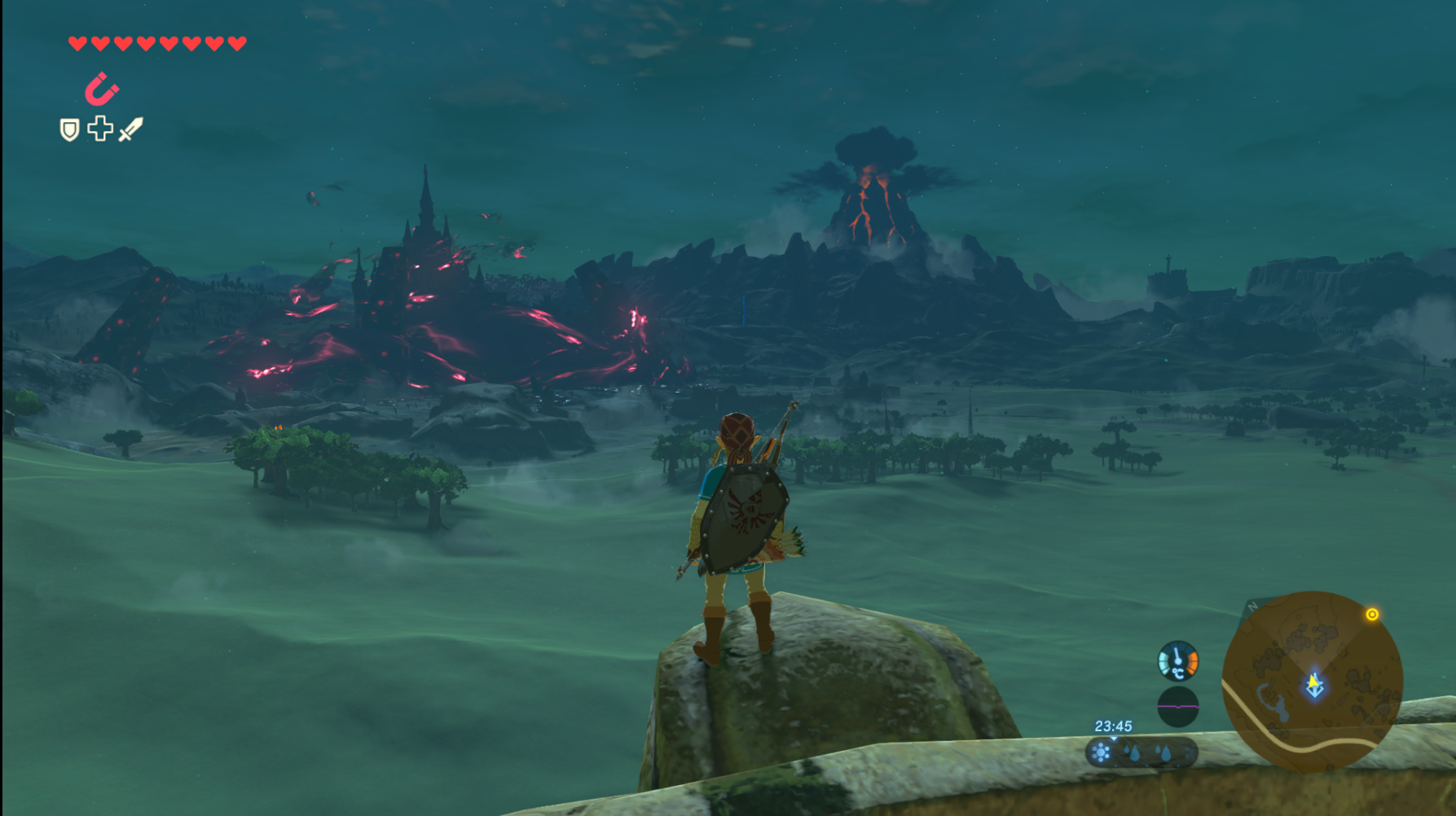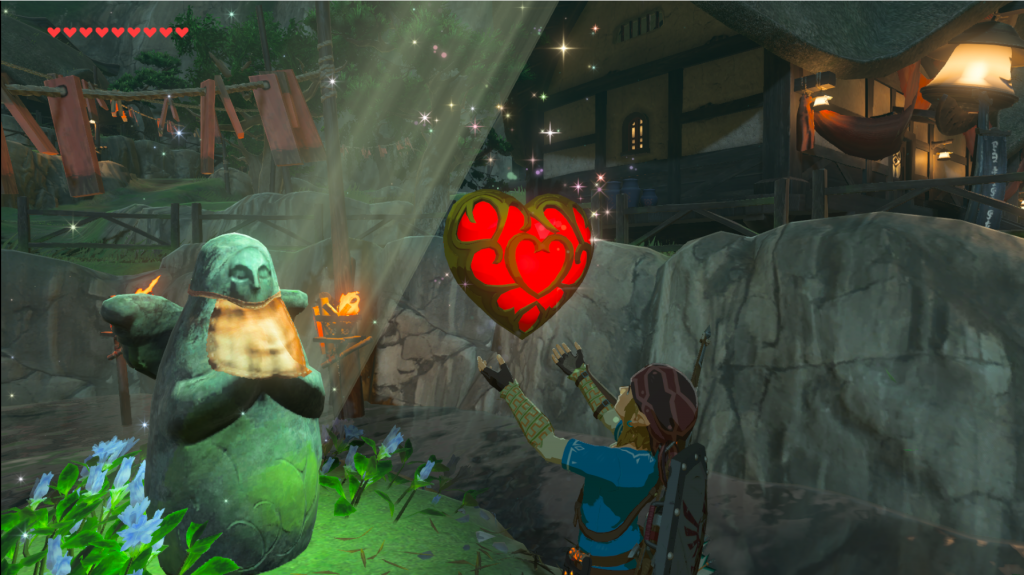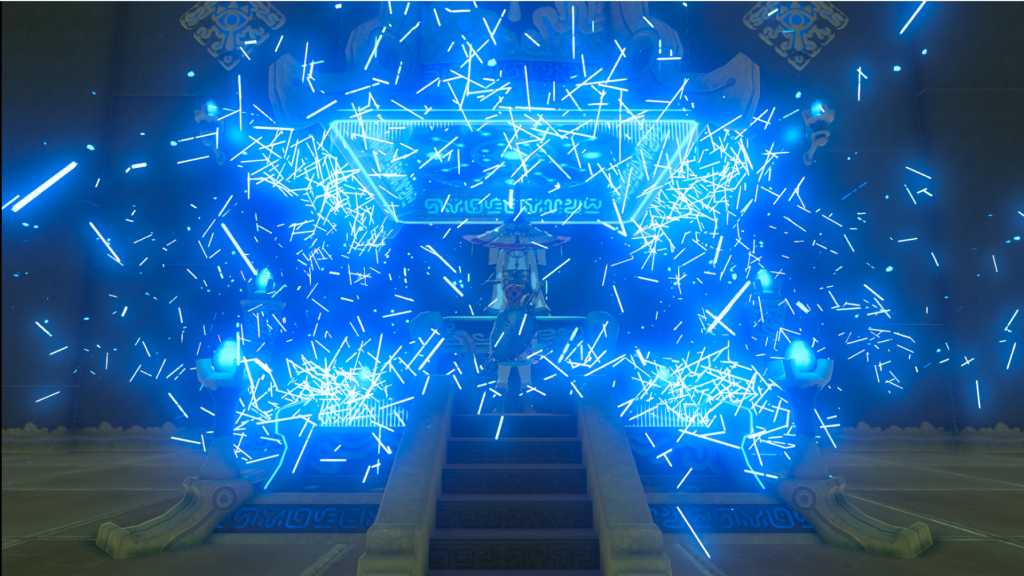The Legend of Zelda: Breath of the Wild (BotW for short) is a game of extremes. At times, it can be an incredibly fun and polished trek through a fantastic open world. But also at times, it can be an incredibly frustrating experience. It’s never frustrating for very long, but the moments of frustration are the many small bits of gristle in an otherwise well-cooked and seasoned steak.
In BotW, you play as Link, the Hero of Hyrule. Only, instead of defeating the great evil of Calamity Ganon, you actually died and have been in a stasis/healing chamber for 100 years while Princess Zelda has held back the darkness. You wake up, having lost your memories and your power. It’s up to you to traverse the land, regaining your power and finding allies to help you finally defeat Ganon. Or just run straight at him and kill him right off the bat – the game lets you do that, too.
In fact, the game lets you do practically anything you want given the tools available to you. Since you can climb almost any surface and use a paraglider to fall from almost any height, that amounts to almost anything. That’s not even mentioning the superpowers you get from your iPhone XXV…errr…Sheikah Slate. Unfortunately, this freedom does have a few glaring exceptions, and the frustration is amplified by the subversion of the game’s own mechanics. This shows up most noticeably in the climbing, combat and stamina, and the item/shrine mechanics.
The climbing mechanic – implemented otherwise fantastically – interacts with the weather. When it is raining, you slip and slide while climbing – preventing you from successfully scaling cliffs or towers during these brief periods. That doesn’t sound unreasonable, and it certainly seems realistic; well, as realistic as the “climb anything” mechanic can be. Unfortunately, this leads to the following scenario: you’re halfway up a fortress or tower, and it starts raining. Your only option to move forward is to climb, and you can’t do that because it’s raining. The easiest thing you can do is wait for the rain to stop – 2-5 minutes of just sitting in one spot, twiddling your thumbs. The best option to progress in a game should never be: “stop playing the game.”
The combat is simple: you can either block or attack. That seems reasonable, except that those are your only two options, and there’s no limit to either of them. If you have shields, you can block indefinitely. If you have weapons, you can attack indefinitely (until all your items break). The biggest limitation to stun-locking an enemy is that they occasionally fly away from the force of your blows and you have to run up to hit them again. If you’re blocking, no attack hurts you in the slightest… except when the game decides you weren’t actually blocking that enemy, and does the full damage of the attack (often killing you instantly in the early game).
It’s impossible to talk about z-targeted combat without bringing up the king: Dark Souls. And in the comparison between them, there are two main differences. First, in Dark Souls, enemies are tough and varied. Especially in DSIII, enemy movesets are complex and reactive – adapting to your fighting style if you aren’t paying attention. This makes combat challenging – Zelda doesn’t need that to be a good game, since Zelda isn’t about complex combat. Second, BotW’s enemies will frequently do enough damage to kill you in one hit (which replaces challenge with difficulty), but they almost never get that chance. The second difference is the more important – Dark Souls uses stamina to manage combat. The enemies use it (well, most of them), you use it. You can’t attack forever. If you try, you’ll run out of stamina and won’t be able to block the counterattack. Contrasted with BotW, combat is quite conspicuously the one place you don’t manage stamina (even horses have carrots spurs). It is such a glaring omission that I would almost guess that it was removed to make combat simpler at some point in development. For the most part, this makes stamina a strange, vestigial mechanic.
Stamina is used for three things in BotW: running, gliding, and climbing. But there’s a problem. I used my first two upgrade points to increase my stamina bar, and there is no longer any real limitation to any of those three activities – the stamina just adds wasted time. Running has to be managed so you aren’t slowed down to a crawl while it recovers, but is otherwise infinite and mindless. Gliding works across almost any distance – the occasional exception just adding some time running, not challenge, to any journey. But climbing is the worst offender. Though scaling any cliff is entirely doable, it must be done at a slow pace. There is a “leap” which speeds up climbing substantially, but it uses more stamina. Once again, this is realistic. Once again, this just makes scaling the cliff slower and more frustrating – not more challenging. There is an armor set that increases your climbing speed – but, oh, you can’t use it on most mountains. It’s too cold or hot, and you have to use your cold or hot armor set there (or cook food and elixers, I suppose). Which means minutes doing nothing but holding up until you get to a ledge, waiting for stamina, then continuing the mindless climb. My complaint isn’t that stamina shouldn’t be used for climbing. My complaints are that the game forces you to use your slowest pace and that there are no truly impossible climbs (or glides) after leveling up stamina once or twice.
Now we come the item system (and with it, the shrine challenges). Finding an awesome sword called the “Edge of Duality” is cool. Finding three of them makes it less cool. Finding out that no matter what they’re made of, they break about as quickly as paper mâche and are entirely unrepairable, makes it just one more thing Link carries around in his inventory (an inventory that no matter how often I sort, I can’t figure out exactly what it is sorting by). Compounding this problem is the limited inventory. Just found an awesome sword? Well, you’ll have to drop a different awesome sword you picked up five shrines ago and haven’t used yet to keep it. Once again, a Dark Souls comparison: items degrade, and if you don’t repair them (or, in III, rest at a bonfire) they will eventually break. But it takes a long time. But you can repair them. You get to like the weapon you use, even if it isn’t the one with the highest numbers. You invest in your weapon – make it yours – and you can make it through the game with any weapon. BotW doesn’t need this – and I get that the developers wanted people to use different weapons – but the path to that would be by making weapons that aren’t clearly superior to one another, by making them break less frequently, and by letting you repair them. You could still be in the middle of a fight when your weapon dulled and frantically switch to another, but it wouldn’t devalue a sword with a name as cool as the “Edge of Duality”.
The counterpart to this are the shrines and Korok seeds. Essentially, these are the primary rewards for exploration (though there are a remarkable number of chests just sitting around, which must just be ignored for fear that they are mimics Octoroks). Korok seeds are tiny puzzles or small challenges scattered throughout Hyrule. The Korok seeds can be traded in for more inventory slots. I enjoy them and certainly don’t need that much inventory space, but it is a little disappointing when you scale a mountain to find a suspicious rock at the top – everywhere you can go, a Korok has gone before, apparently. Sometimes the view can be reward enough. The more in-depth exploration rewards are the shrines. Almost every shrine contains a mini dungeon with some puzzle or series of puzzles, ending with the reward of a Spirit Orb. Spirit Orbs are used to upgrade health and stamina. Joseph Anderson was critical of them by saying that they were generally too simple and not Zelda enough, but I think they are a good addition – though they would be vastly improved by a more generous item system, because the non-orb rewards would be more meaningful. My only real complaint specific to shrines is that I wish they had varied architectural styles. Every shrine looks exactly the same, and it starts to blend together. Despite this, it’s a welcome respite from exploration – a fun little mini-game to break up your time. Could there be more complex dungeons? Yes, and that would make a better game. But it’s not necessary for the game to be fun.
This brings us to the last piece of gristle stuck in my teeth: there are quests in this game, but doing almost anything but the main quests is going to result in quite a bit of fetching for not a lot of reward. It’s fun to do the occasional thing a passer-by asks, but letting your quest log fill up like Skyrim is a good way to burn yourself out. It’s strange, but the game is better played without this – and I think that’s okay. You’re a traveler in a strange land – running in to a Rito playing the accordion or wasting time gathering lizards can both be fun as long as you don’t fall into a completionist mindset. I wish there were fewer of these – well, just the fetching ones – but they’re ignoreable, so I can’t complain too much.
Despite its issues, Breath of the Wild is still a fun game. It’s not a perfect game and I’m not sure I can even call it a great game, but it did let me mention Egoraptor, Joseph Anderson, and Dark Souls in one review. That’s a trifecta, right there. I’m re-watching Joseph Anderson’s review (which I saw … almost exactly a year ago) as I edit, and I can see I’m saying many of the same things in different ways, having now played it for myself. They addressed many of Egoraptor’s complain about the 3D Zelda games. They took some cues from Dark Souls (which had taken some cues from Ocarina of Time….circle of life and all that), though ignored many others. If all open world games were like this, the world would be a better place (though, clearly, the BotW team must have hired an errant Ubisoft employee who insisted on revealing the map through towers, rather than exploration). Nintendo have made a flawed masterpiece – one I intend on finishing, even if there are parts that are incredibly frustrating.
EDIT: 2018-05-10: After writing this review, I had intended to go back to play more. However, I have felt no motivation to do so – all my desire to continue playing ended after discovering the last tower and revealing the final piece of the map. All I saw in store was more mediocre combat and fetch quests – a feeling that was only confirmed by each new quest I ran across. For this reason, I am downgrading Breath of the Wild to Tier Two.
Nintendo Link (heh – Link)



Without mods, I feel like BotW is a better version of Skyrim, for the simple fact that exploration is not only rewarded, but demanded to progress within the game. Sometimes finding something as simple as a knight’s sword stuck into the top of a half-buried rampart is all it takes to make the hike up to it feel meaningful.
As for the weapons breaking–you just have to embrace it with a throw-away mentality (you can practice this skill in any of the Dead Rising games). Gamers love to be hoarders, saving their best potions, strongest spells and most potent limited-use weapons until the very end of the game (and even then, sometimes we won’t use them out of stubbornness). Similar to the way that you can’t try to be a completionist with the quests or risk burnout, the best practice with weapons is to just use whatever the heck you want, whenever you want and not worry about durabaility. Sometimes I fight exclusively with bombs. Or fish with bombs. Or fight with a rock and the magnet wand. Of course, I was playing on Master Mode, where enemies take a bajillion hits, so I almost never had any decent weapons anyway.
BotW *isn’t* a normal Zelda game. It doesn’t have the big complex dungeons that we’ve become familiar with. It doesn’t have a lot of unique special items that change up how you fight and interact with the environment. I don’t think BotW could have these things and maintain what its final presentation is today. However, the Zelda franchise has been in a rather precarious spot of late. Most people agree that Ocarina of Time is the quintessential benchmark for what a Zelda game should be. Majora’s Mask is the quintessential benchmark of what a Zelda game could be. Ignoring the relative success of the handhelds (which for the most part have been great) and the multiplayer Zeldas (4-Swords), AND the spin-offs (Hyrule Warriors), the actual main Zelda line has been stale and/or dying. We all have fond memories of Midna and Twilight Princess Zelda (the character), but Twilight Princess was trying too hard on the surface level to just be a recreation of Ocarina of Time. It didn’t feel all that new, and not enough time had passed since OoT to warrant a revisitation of the old. Skyward Sword is an absolute joke of a game, which might possibly possess the accolade of being the worst Zelda game to come out in 30 years. In a lot of ways, BotW needed to happen–it needed to be this odd, not-perfect Zelda game that tried something new. It needed to break the mold of what was considered normal for the main Zelda line. BotW gives us a fresh look on the Zelda universe–and if in the next one or two Zelda games they decide to revisit a more standard gameplay, we’ll be a little more interested in it due to the time that has passed and advancements in technology since then.
I can see what you mean about stamina being a waiting game, but once again, I think that was the point. It forces you to move slowly. It incentivises you to find alternate routes. Raining creates the same dilemma–it forces you to play the game on-foot for a little while, and explore the world in a new way–chances are, you’ll find something that you would have missed for moving too fast otherwise. If I’m honest though–the entire game is a “waiting” game. Nothing is terribly hard, or mind-numbingly challenging within the game. There’s no great boss Dark Souls-ian boss that you’ll die against fifty times, nor any puzzle that takes hours of note-taking and critical thinking like the island of Myst; the game is like a vacation. You travel around, you pick up useful things, you take pictures, you get items, you solve simple puzzles–none of these things take much effort, but in their own way are a relaxing fun pastime.
That all being said, this is all simply my own perspective of the game–none of your complaints (or most anyone else I’ve heard talk about it) are invalid. BotW certainly is an interesting title in the Zelda franchise that came out of left field for most of us; and agreed, it is not a perfect game (but few are).